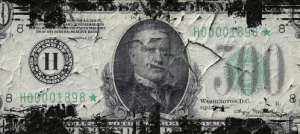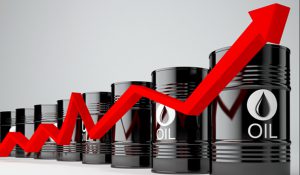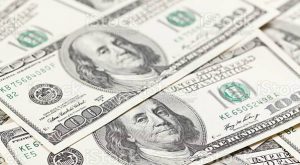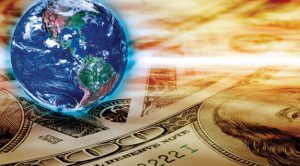Financial Collapse Is a Mathematical Certainty: The Perfect Storm Threatening the Dollar Hedgemony (2)
Sam Parker of Behind The News Network has written an excellent commentary on the coming financial collapse and the inevitable fall of the U.S. dollar’s status as the global reserve currency.

Starting with World War II, Parker documents a historical perspective on the rise of the U.S. dollar to help the reader understand how we got to where we are today, including the role of the covid Plandemic.
The Perfect Storm Threatening the Dollar Hedgemony – Part 1 (of a 3 Part Series)
(Continuation)
by Sam Parker
Read the first part of the article
Oil & the October 1973 War
The backdrop to the oil shortage and rising prices was an unstable Middle East. The Arabs were feeling frustrated with the West in regards to Israel. Anwar Sadat became the new president of Egypt after Nasser’s death in 1970. By the end of 1972, Sadat decided he would have to go to war.
By April 1973, these plans were finalized. The only people who knew the specifics of these war plans outside the few within the high commands of Syria and Egypt was King Faisal of Saudi Arabia; and, of course, Kissinger and his boss, David Rockefeller.
And this meant that oil would be central to the coming conflict. Control of the flow of resources has been of strategic concern throughout history. Asserting pricing and currency control over the oil was the main game plan.
In 1973, all the pieces on the chessboard were being aligned to fit into the Rockefeller game plan. New York decided to launch a colossal assault against industrial growth in the world, in order to tilt the balance of power to the advantage of Wall Street financial interests.
In order to do this, they determined to use their most-prized weapon – control of the world’s oil flows. Never in history had such a small circle of interests controlled so much of the world’s destiny. Their scheme was utterly outrageous, and that was to their advantage.
May 1973 – Bilderberg Meeting
The Bilderberg Group is a private policy-making group, founded in 1954 by David Rockefeller. This is a common policy body for the Rockefeller and Rothschilds’ “Networks of Power”.
The annual Bilderberg meetings gathered top elites from the US and Europe for secret meetings and policy discussions. Consensus was then shaped in subsequent press comments and media coverage, but never with reference to the secret Bilderberg talks themselves.
In May 1973, with the dramatic fall of the dollar still fresh, a group of 84 of the world’s top political and financial insiders met at a secluded island in Sweden belonging to the Wallenberg family. This family was in the Rothschild orbit, and controlled Sweden in the same way that the Oppenheimer family controlled South Africa.
The gathering was told of an imminent conflict in the Middle East, which would result in the price of oil going up by 400%. The purpose of the meeting was not to stop the war, but, rather to plan and manage this coming flood of dollars, a process Kissinger called “recycling the petro-dollar flows”.
The Arab oil-exporting countries would see their oil income jump by 400%, and their economies could not absorb this cash, thus, this surplus cash would be deposited in select banks belonging to the 2 families.
On September 28, David Rockefeller paid a visit to Sadat in Egypt. He had visited Sadat several times in the preceding 3 years. The message from David to Sadat was that it was now “time to heat the temperature up in the region”. There could be no clearer signal for GO.
A week later, on 6 October, 1973, Egypt and Syria launched the October War against Israel. The entire constellation of events surrounding the outbreak of the October War, and its aftermath was secretly orchestrated from New York, using the powerful and secret intelligence channels established by Kissinger.
The Rockefellers scripted the war and its aftermath along the precise lines of the Bilderberg meetings 5 months earlier. The Rothschilds knew all along, and they instructed Golda Meir, the Israeli prime minister, that at no stage must she pre-empt by attacking first.
In response to the American resupply of arms to a hysterical n beleaguered Israel, on 16th October, OPEC met in Vienna and raised the price of oil by 70% to $5.11 a barrel. That same day, the Arab oil producers instituted an oil embargo against the Western supporters of Israel. A day later, they instituted a production cutback.
Following a meeting in January 1974, yet a second price increase of more than 100% was added, bringing the price of oil to $11.65 per barrel. The Rockefeller plan achieved its target of a 400% increase in the price of oil, some 8 months after Bilderberg meeting in Sweden.

This was done on the surprising demand by the Shah of Iran, who had been secretly told to do so by Kissinger. Pressure was put on Saudi Arabia to agree to this.
Resistance came in the form of the finance and foreign ministers of Saudi Arabia. On one December afternoon, both of these officials were killed by the CIA, one in Washington, and the other in New York (see the full story of this in the article “The Saudi-US Nexus”).
By March 1975, this new oil-price mechanism was a done deal. Oil would be sold only for dollars.
Because the world had to buy oil, and pay for it in dollars, the world’s demands for dollars could only increase. Even though dollars could no longer be exchanged for gold, they were now exchangeable for oil!
The dollar was now backed by oil. It became known as the petro-dollar.
If any oil-exporting nation demanded payment for its oil in any other currency besides the dollar, that nation had to be convinced, either by political pressure or military means, to change its mind.
The GOLD-DOLLAR had now been replaced by the PETRO-DOLLAR! The only limit was how many dollars the rest of the world would be willing to accept on the full faith and credit of the US Government.
The ensuing results were rapid inflation. The bulk of OPEC’s dollar revenues were deposited with the leading banks in London and New York, the very banks which dealt in dollars and the international oil trade.
This Petro-dollar arrangement proved very valuable for the dollar, and the Rockefeller-tied oil and banking giants. The world was forced to buy immense amounts of dollars continuously to purchase oil.
One consequence of this was the emergence of these few banks and oil companies (such as Exxon, Mobil, Chevron, Texaco), in New York, as giants of world industry. These banks and oil companies so overwhelmed the scale of ordinary companies that their power and influence seemed invincible.
Third World countries were forced to divert precious funds from industrial, agricultural and social development into simply paying for their massive oil import bills, which, of course, had to be paid in dollars. It was a double blow for these countries, as exports of their raw materials and commodities declined greatly due to the recession in the industrialized world.
The Aftermath
Despite the economic and financial shocks which ensued from this Oil Shock, by late 1975, certain parts of the world began to resume industrial development. For the Third World, the oil shock spelled an end to development and a reversal of hopes for a better life that had emerged during the 1960s.
In this period, four new policies were put in motion. The most dangerous was the fourth policy.
In 1972, David’s eldest brother, John D Rockefeller the 3rd, wrote and published a book called The Second American Revolution. It acted as a blueprint for the next two decades for policy-planners in America.
In 1975, the elite policy-making think tank of the Rockefeller family, the New York-based Council on Foreign Relations (CFR), drafted a series of policies blueprinted- taken from this book – for the 1980s. Its theme was a policy of “controlled-disintegration” of the world economy.
What was disintegrating was the entire fabric of industrial and agricultural development, from the 1st World to the 3rd World.
The aim here was that many countries would become financially weak, thus in no position to negotiate better deals with creditor banks in New York and London. They would be forced to adopt policies that resulted in “privatization and deregulation,” and allowing easier access to western capital into their countries. In this manner, the best and choicest resources and companies would be taken over, “on the cheap”, and by US and British banks and companies.
Now, as we have seen many Third World countries suffered huge trading deficits – due to higher oil import bills and lower exports receipts, they were forced to go cap-in hand to the banks in New York and London, for dollar loans, to bridge this gap. These banks stepped into the breach to lend the “petro-dollars” to these countries, but only to “balance” the accounts, and not to finance development.
Since at least the beginning of the 1970’s Washington has deployed similar tactics of economic blackmail and destabilization to force what has become a global domination not of US manufactured goods, but rather of the dollar as world reserve currency. For almost five decades, since August 15, 1971, Washington and Wall Street have used their dominant position to force inflated paper dollars on the world, cause financial bubbles and subsequently debt buildup to impossible levels, then collapse.

The US economy since 1971 has been turned into a financial revenue source, in effect turning the United States from a nation primarily producing industrial goods to one in which the sole aim of all investment is to make money from money. In short, the economy was financialised.
The process took place over decades. By 2000, Wall Street banks and investment funds essentially dominated the entirety of the US economy.
Manufacturing jobs had been pushed offshore, “outsourced,” by pressure from those same Wall Street banks that since the 1980’s had driven corporations to focus only on the value of their stock shares and not on the soundness of their products. Leveraged Buyouts, Shareholder Value became bywords. Corporate heads perished if Wall Street banks did not approve their financial profit returns.
What that has left today is a United States that is primarily a services economy, a debt-bloated consumer economy and no longer a great industrial leader.
The so-called upper 1% of US oligarchs are demanding similar tribute from the rest of the world to sustain the unsustainable.
Even using the US government inflation measure what a US citizen could buy in 1970 for $385 in terms of food, clothing and other necessities, a person would need $2,529 today.
That is a direct consequence of the Nixon gold decoupling. In a stroke of the pen, Nixon and Wall Street had removed the threat of a gold cap on foreign dollar debts. The debts soared and Washington and Wall Street today have a dollarized world trade system where US Treasury sanctions are becoming commonplace as weapons of war to force friend and foe alike to join lock step behind Washington demands.
The style has changed in US economic blackmail since the 1970’s, but not the content.
New York and the Rockefeller family had the world in its grip. All of these will serve as a backdrop to the ongoing collapse of the dollar system, and how international finance began to dominate all other sectors of the global economy. It was based on a flawed system, which would have devastating consequences in the coming decades.
Economics of Empires
A nation-state taxes its own citizens, while an empire taxes other nation- states. The history of empires teaches that the economic foundation of every single empire is the taxation of other nations.
The imperial (a very polite world for looting and raping) ability to tax has always rested on a better and stronger economy, with a better and stronger military. One part of the subject taxes went to improve the living standards of the empire; the other part went to strengthen the military dominance necessary to enforce the collection of those taxes.
Historically, taxing the subject state has been in various forms; whatever economic goods the empire demanded and the subject state could deliver. Imperial taxation has always been direct; the subject state handed over the economic goods directly to the empire.
When the dollar transitioned from a gold-backing to a Petro-dollar, things began to change for the worse in the global economic field.
For the first time in history, in the 20th century, America was able to tax the world indirectly, through inflation. It did not enforce the direct payment of taxes like all its predecessor empires did, but distributed instead its own currency, the US dollar, to other nations in exchange for goods with the intended consequence of inflating and devaluing those dollars and paying back later each dollar with less economic goods – the difference capturing the American imperial tax.
We have read how this happened.
Essentially, the US declared itself to be an Empire. It had extracted an enormous amount of economic goods from the rest of the world, with no intention or ability to return those goods, and the world was powerless to respond.
The world was taxed and it could not do anything about it. From that point on, to sustain the American Empire and to continue to tax the rest of the world, the US had to force the world to continue to accept ever-depreciating dollars in exchange for economic goods. It had to give the world an economic reason to hold even more dollars, and that reason was oil.
“Controlled Disintegration”
During 1975 the CFR (Council on Foreign Relations-the premier Rockefeller think tank, which shapes policy for the family) drafted a series of policy blueprints for the 1980s, much as they had done at the crucial turning point in the 1957 recession.
And this new policy, in turn, used John D Rockefeller’s 1972 book, The Second American Revolution, as its inspiration.
The CFR stated, in its account, that “a degree of controlled disintegration in the world economy is a legitimate objective for the 1980s”.

What was disintegrating, however, was the entire fabric of traditional industrial and agricultural development in the Third World. The first World was not left out either.
The decade of the 1980s would widen the gap between the very wealthy (the 1%) and the masses. And the elite would serve the 1%.
This fact was not being made available to the masses, because “they would not understand”. The elite must shape the illusion in what was termed the “manufacture of consent”.
The American version of this model would be shaped by an aristocracy of money, rather than the British version which relied on blood aristocracy of birth.
But increasingly, as a consequence of the economic policy decisions of the Rockefeller Empire, the United States became transformed.
America, once the ideal for freedom for much of the world, was transformed, step-by-step, into the opposite, and at a quickening pace during the 70s and 80s, while she retained a rhetorical facade of “freedom and liberty”.
Long-term government-funded infrastructure- such as railroads, highways, water, and sewage and power construction was devastated by this policy in the early 1980s. The world steel industry was forced into its worst depression since the 1930s. The aim was to shift economic policy throughout most of the industrialized world away from the direction of long-term industrial and nuclear development.
The relative power of the two families was thus set to become dominant again, in which Wall Street would call the shots, rather than industrial development. Financial speculation was more important and profitable than building a factory. What followed in the decade of the 1980s and 90s would have appeared inconceivable to a world which had not already been stunned and disorientated by the shocks of the 1970s.
In 1980, Rockefeller man Paul Volcker was put as the head of the Fed. Immediately, the Fed raised interest rates to 20% – 3 times what is was a year earlier. This had the effect on America’s economy. No infrastructure development, industrial enterprises closed down, and more.
This was a deliberate collapse of America’s industrial base. In addition, this also cut off further investment in long-term infrastructure and industry. In the future, American production would be moved to cheap-labor countries, such as Mexico, Taiwan, and later to China.
Internationally, this interest rate increase devastated the economies of the Global South. This achieved lower prices paid for raw material exports to the Collective West, besides the increase in debt payments to the Anglo-American banks.
Overall, the 1980s paved the way for American multinationals to expand globally, breaking down barriers across the world. This, in turn, made it easier for the Rockefeller Empire to “globalize” the world economy.
Globalization
Globalization has been emerging since the 1960s but did not gain its name and widespread recognition until the 1990s, shortly after the fall of the Berlin Wall.
Multinational corporations had existed for decades, but the new global corporation was different. A multinational corporation has its roots and head office in one country, but has operations in many other countries.
The new global corporation was just that – global. It submerged its national identity as much as possible and forged a new identity as a global brand stripped of national distinction. Decisions about the locations of factories and distribution centers were based on considerations of cost, logistics and profits without regard to affection for a nominal home country.
Globalization emerged not through the initiation of any new policies, but through the elimination of many old ones. From 1945 to 1990, the world was divided not only by the Iron Curtain separating the communist and capitalist spheres, but also by the restrictions imposed by capitalist countries themselves. These restrictions included capital controls that made it difficult to invest freely across borders.
The world was highly fragmented, discriminatory and costly for firms with international ambitions. By the late 1990s, these costs and barriers had mostly been removed. Taxes were reduced or eliminated; capital was able to move freely across borders; labor mobility improved; stock exchanges deregulated and merged across borders to create global giants.
The expansion of the EU created the world’s richest tariff-free market, and the launch of the Euro eliminated countless currency conversions and their costs.
Russia and China rose as new capitalistic societies eager to adopt many of the global norms they saw emerging in Western countries. Economic and political walls were coming down while, at the same time, technology brought about an ease in communications.
Infinite risk in a borderless world was the new condition of finance.
Globalization increased the scale and interconnectedness of finance beyond whatever had existed. While issuance of bonds was traditionally limited by the use to which the borrower put the proceeds, derivatives had no such natural limit. They could be created in infinite amounts by mere reference to the underlying security on which they were based.
The ability to sell Nevada subprime mortgage loans to German regional banks after the loans had been bundled, sliced, repackaged, and wrapped with worthless triple-A ratings was a wonder of the age.
In a globalized world what was old was new again.
A first age of globalization had occurred from 1880 to 1914, where the wonders were steamships, telephones, radio, and the combustion engine.
The second period was from 1999 to 2006, where it was the internet, cell-phones, etc.
In 1990, China opened up to trade and investments. At the same time, Russia had finally begun to throw off its late feudal model and modernize its industry and agriculture, and a unified Germany was becoming an industrial and economic giant.
One of the benefits to the Rockefeller Empire was that by shifting production to China, it helped to slow the growth of oil consumption within the US.
The reverse happened in China. China was a net exporter of oil, but due to increased levels of production, China became a net importer of oil in November 1993.
From this point on, New York reckoned that it could dictate the future of China, through its control of oil flows. The effect of such developments on finance was much the same at the turn of the century. Bonds could be issued in Argentine, underwritten in London and purchased in New York. Oil could be refined in California and shipped to Japan on credit provided by banks in Shanghai.
Two world wars, two currency wars, the end of the Cold War, and the fall of empires, would pass before the new age of globalization began.
In 2016, international finance is omnipresent; whether it is here to stay remains to be seen. History shows that civilization and globalization it represents are no more than a thin veneer on the jagged edge of chaos.
yogaesoteric
December 7, 2022
